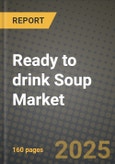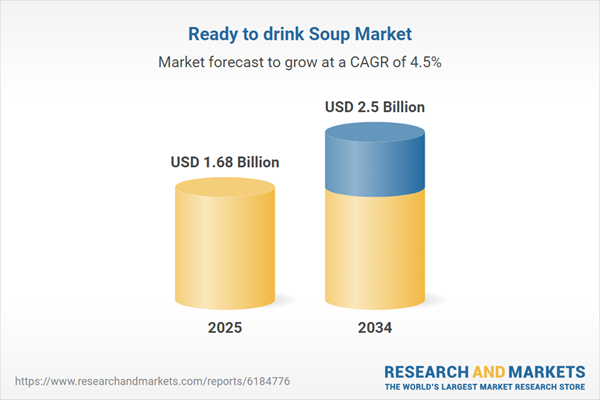Ready to drink Soup Market
The ready‑to‑drink (RTD) soup market refers to packaged soups that require minimal to no preparation - typically premium chilled or shelf‑stable formats that consumers can heat and consume on‑the‑go or at home without cooking. These products span retail and food‑service channels, encompassing vegetable, cream, meat or plant‑based formats, and are packaged in bottles, cartons, pouches or microwavable containers. Recent trends include the rise of single‑serve convenient meals, premiumisation of functional/clean‑label soups (e.g., low‑sodium, organic, plant‑based), increased demand for “heat & eat” comfort foods after remote‑working shifts, and innovation in packaging (microwavable pouches, eco‑friendly bottles). Growth drivers include busy lifestyles, increasing urbanisation, higher disposable incomes, greater penetration of convenience retail channels, and consumer demand for healthier, portion‑controlled meals. The competitive landscape is composed of large established food‑brands launching RTD soup lines, niche premium brands focusing on clean‑label and functional formats, and local/regional producers addressing taste‑localisation and cost‑sensitive segments. Other dynamics include supply‑chain complexities for chilled formats, raw‑material cost inflation (vegetables, meats, packaging), growing reformulation pressure (e.g., sodium reduction), and regional variation in consumer soup‑consumption habits. Overall, the RTD soup market is well‑positioned for above‑average growth as convenience and wellness imperatives accelerate - but success will depend on taste, health credentials, packaging innovation and distribution reach.Ready to drink Soup Market Key Insights
- Convenience is core - Consumers with limited time increasingly turn to RTD soups as quick meal solutions, replacing traditional cook at home options or snacks.
- Health & wellness credentials matter - Clean label claims (organic, “no preservatives”, plant based, low sodium) and functional formulations (immune boosting, ingredient transparency) are becoming differentiators.
- Single serve and on the go formats gaining share - Smaller pack, microwave/heat and eat formats appeal to busy professionals, students and urban households.
- Plant based/vegetarian formats accelerating - With rising flexitarian/vegan diets, vegetable based soups, legumes/pulse soups and meat free versions are gaining traction.
- Packaging innovation is a driver - Retail friendly, shelf stable or chilled formats, easy open packaging and sustainable materials are key to capturing consumer attention and improving distribution.
- Premium pricing and flavour innovation support growth - Premium soup lines with exotic flavours (ethnic cuisines, gourmet ingredients) and higher price points are expanding beyond basic value segments.
- Retail & e commerce distribution expanding - Growth in modern grocery retail, convenience store chains, online grocery and direct to consumer channels is facilitating broader reach of RTD soup.
- Raw material cost and simpler alternatives pose constraints - Vegetable/meat price inflation, packaging cost growth and competition from cheaper snack/meal alternatives challenge margins and pricing.
- Regional taste preferences and consumption culture vary - Consumer adoption depends heavily on local appetite for soups, warmth in meals, and snacking conventions; localisation of flavours is important.
- Sustainability and waste reduction trends emerging - Brands are responding to packaging waste concerns, cold chain logistics costs (for chilled soup formats) and consumer demand for more eco friendly solutions.
Ready to drink Soup Market Reginal Analysis
North America
The region features strong growth in RTD soups thanks to busy urban lifestyles, high prevalence of single‑household households, and well‑developed retail channels including convenience stores and e‑commerce. Premium/organic and plant‑based variants are gaining traction, though price sensitivity and intense competition challenge margin expansion.Europe
Europe exhibits moderate growth, driven by convenience needs, snacking culture, and increasing interest in healthy foods. The market benefits from strong grocery retail infrastructure and premium brands, though fragmented country‑markets, varying regulatory standards and higher cost bases moderate expansion.Asia‑Pacific
APAC represents the fastest‑growing region for RTD soups, propelled by rapid urbanisation, rising middle‑class incomes, expanding modern retail and changing meal‑patterns (more away‑from‑home, more snacks/quick meals). Local flavour adaptation (spicy, regional soups) and growing online grocery make this region a key growth engine.Middle East & Africa
In MEA, adoption is emerging - growth is supported by younger demographics, growth of convenience retail, and demand for ready meals in urban centres. However, high import costs, less mature chilled/RTD infrastructure and lower per‑capita premium spend slow rapid scale‑up.South & Central America
Latin America offers incremental opportunity for RTD soup growth as modern retail expands and consumer lifestyles shift. However, economic volatility, logistics challenges, and reliance on imports or low‑cost local production limit rapid premium‑segment growth.Ready to drink Soup Market Segmentation
By Ingredient
- Vegetarian soup
- Non-vegetarian soup
By Nature
- Organic
- Conventional
By Packaging
- Bottles
- Cans
- Packets
By Distribution Channel
- Online
- Offline
Key Market players
Campbell Soup Company, Unilever, The Kraft Heinz Company, General Mills Inc., Amy’s Kitchen, The Hain Celestial Group, Pacific Foods, Baxters Food Group, Blount Fine Foods, Progresso, Knorr, Trader Joe’s, Nestlé SA, Maruchan Inc., Hormel FoodsReady to drink Soup Market Analytics
The report employs rigorous tools, including Porter’s Five Forces, value chain mapping, and scenario-based modelling, to assess supply-demand dynamics. Cross-sector influences from parent, derived, and substitute markets are evaluated to identify risks and opportunities. Trade and pricing analytics provide an up-to-date view of international flows, including leading exporters, importers, and regional price trends.Macroeconomic indicators, policy frameworks such as carbon pricing and energy security strategies, and evolving consumer behaviour are considered in forecasting scenarios. Recent deal flows, partnerships, and technology innovations are incorporated to assess their impact on future market performance.
Ready to drink Soup Market Competitive Intelligence
The competitive landscape is mapped through proprietary frameworks, profiling leading companies with details on business models, product portfolios, financial performance, and strategic initiatives. Key developments such as mergers & acquisitions, technology collaborations, investment inflows, and regional expansions are analyzed for their competitive impact. The report also identifies emerging players and innovative startups contributing to market disruption.Regional insights highlight the most promising investment destinations, regulatory landscapes, and evolving partnerships across energy and industrial corridors.
Countries Covered
- North America - Ready to drink Soup market data and outlook to 2034
- United States
- Canada
- Mexico
- Europe - Ready to drink Soup market data and outlook to 2034
- Germany
- United Kingdom
- France
- Italy
- Spain
- BeNeLux
- Russia
- Sweden
- Asia-Pacific - Ready to drink Soup market data and outlook to 2034
- China
- Japan
- India
- South Korea
- Australia
- Indonesia
- Malaysia
- Vietnam
- Middle East and Africa - Ready to drink Soup market data and outlook to 2034
- Saudi Arabia
- South Africa
- Iran
- UAE
- Egypt
- South and Central America - Ready to drink Soup market data and outlook to 2034
- Brazil
- Argentina
- Chile
- Peru
Research Methodology
This study combines primary inputs from industry experts across the Ready to drink Soup value chain with secondary data from associations, government publications, trade databases, and company disclosures. Proprietary modeling techniques, including data triangulation, statistical correlation, and scenario planning, are applied to deliver reliable market sizing and forecasting.Key Questions Addressed
- What is the current and forecast market size of the Ready to drink Soup industry at global, regional, and country levels?
- Which types, applications, and technologies present the highest growth potential?
- How are supply chains adapting to geopolitical and economic shocks?
- What role do policy frameworks, trade flows, and sustainability targets play in shaping demand?
- Who are the leading players, and how are their strategies evolving in the face of global uncertainty?
- Which regional “hotspots” and customer segments will outpace the market, and what go-to-market and partnership models best support entry and expansion?
- Where are the most investable opportunities - across technology roadmaps, sustainability-linked innovation, and M&A - and what is the best segment to invest over the next 3-5 years?
Your Key Takeaways from the Ready to drink Soup Market Report
- Global Ready to drink Soup market size and growth projections (CAGR), 2024-2034
- Impact of Russia-Ukraine, Israel-Palestine, and Hamas conflicts on Ready to drink Soup trade, costs, and supply chains
- Ready to drink Soup market size, share, and outlook across 5 regions and 27 countries, 2023-2034
- Ready to drink Soup market size, CAGR, and market share of key products, applications, and end-user verticals, 2023-2034
- Short- and long-term Ready to drink Soup market trends, drivers, restraints, and opportunities
- Porter’s Five Forces analysis, technological developments, and Ready to drink Soup supply chain analysis
- Ready to drink Soup trade analysis, Ready to drink Soup market price analysis, and Ready to drink Soup supply/demand dynamics
- Profiles of 5 leading companies - overview, key strategies, financials, and products
- Latest Ready to drink Soup market news and developments
Additional Support
With the purchase of this report, you will receive:- An updated PDF report and an MS Excel data workbook containing all market tables and figures for easy analysis.
- 7-day post-sale analyst support for clarifications and in-scope supplementary data, ensuring the deliverable aligns precisely with your requirements.
- Complimentary report update to incorporate the latest available data and the impact of recent market developments.
This product will be delivered within 1-3 business days.
Table of Contents
Companies Mentioned
- Campbell Soup Company
- Unilever
- The Kraft Heinz Company
- General Mills Inc.
- Amy’s Kitchen
- The Hain Celestial Group
- Pacific Foods
- Baxters Food Group
- Blount Fine Foods
- Progresso
- Knorr
- Trader Joe’s
- Nestlé SA
- Maruchan Inc.
- Hormel Foods
Table Information
| Report Attribute | Details |
|---|---|
| No. of Pages | 160 |
| Published | November 2025 |
| Forecast Period | 2025 - 2034 |
| Estimated Market Value ( USD | $ 1.68 Billion |
| Forecasted Market Value ( USD | $ 2.5 Billion |
| Compound Annual Growth Rate | 4.5% |
| Regions Covered | Global |
| No. of Companies Mentioned | 15 |









